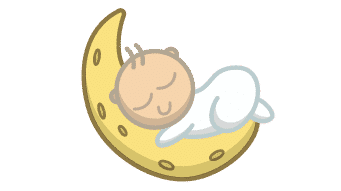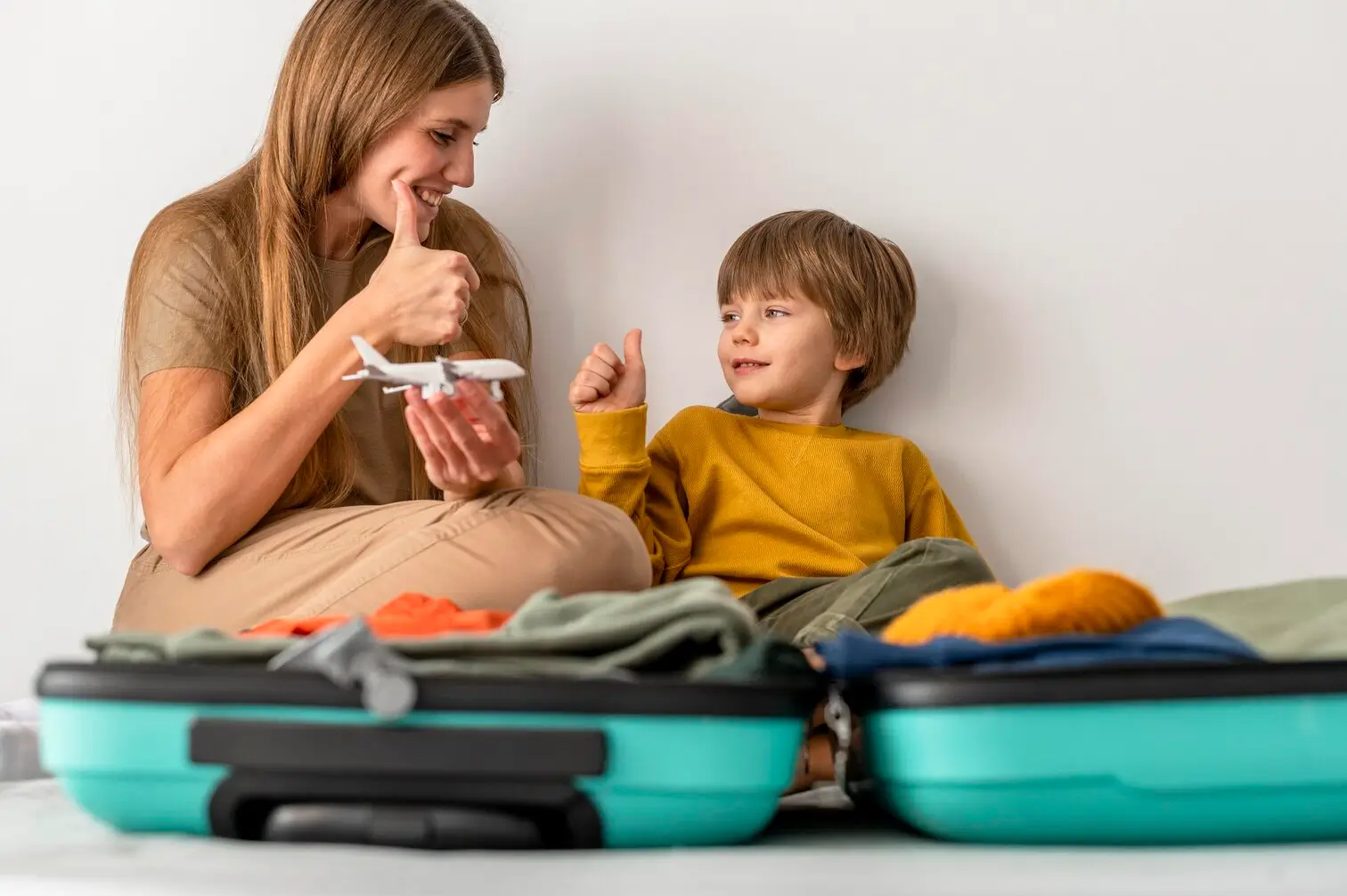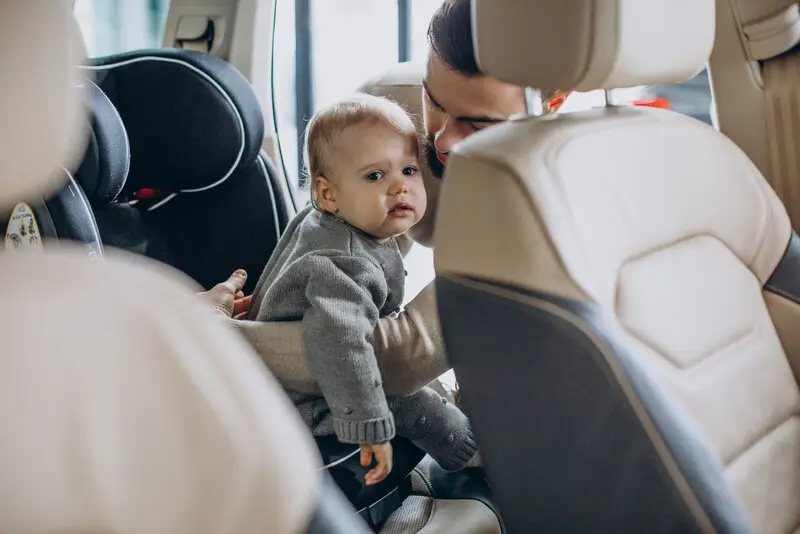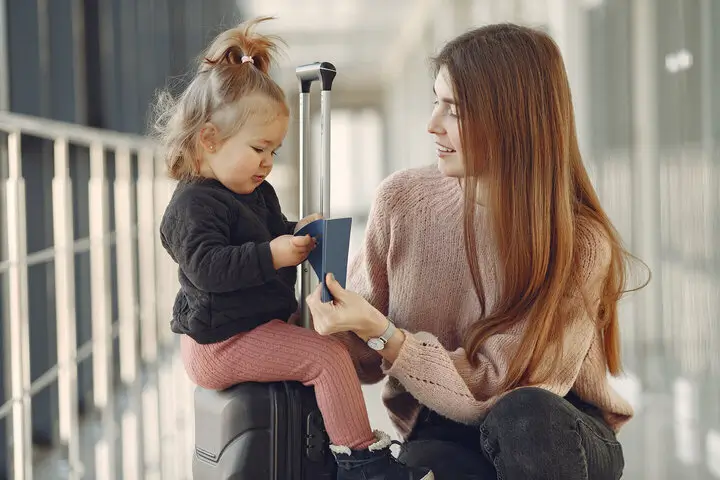Infant travel checklist planning gives parents a simple way to prepare for trips with a baby without last-minute panic. With one clear document, packing turns into a step-by-step routine instead of a guessing game. Clothes, diapers, feeding supplies, sleep aids, and safety gear each get a section, so nothing important slips through the cracks.
A strong infant travel checklist helps for short road trips, international flights, and everything in between. The same structure can support a newborn heading to a grandparent’s house and a six-month-old flying across the country. Only the numbers and a few age-specific items change.
Why an infant travel checklist reduces stress on every trip
A packed schedule, nap windows, feeding times, and unexpected spills already demand enough energy. A written infant travel checklist takes pressure off memory and keeps the process consistent from one trip to the next. Instead of wondering if enough diapers or spare outfits sit in the bag, parents can simply mark each item off the page or screen.
Benefits of using the same checklist for every trip include:
- Less chance of forgetting small but crucial items like pacifier clips or diaper bags
- Easier sharing of tasks between two adults
- Faster packing over time as the routine becomes familiar
- A record of what worked or did not work on earlier trips
The structure in this guide follows a pattern used in many trusted baby travel resources: a section for the carry-on or diaper bag, a section for the suitcase and hotel setup, and a section for larger gear. That pattern fits the flow of a typical travel day, from leaving the house to settling into a new room.
What This Infant Packing List Covers from Start to Finish
A complete infant travel checklist works best as a clear, step-by-step guide rather than a short set of generic tips. This section explains what the overall infant packing list includes and how each part supports real trips with a baby.
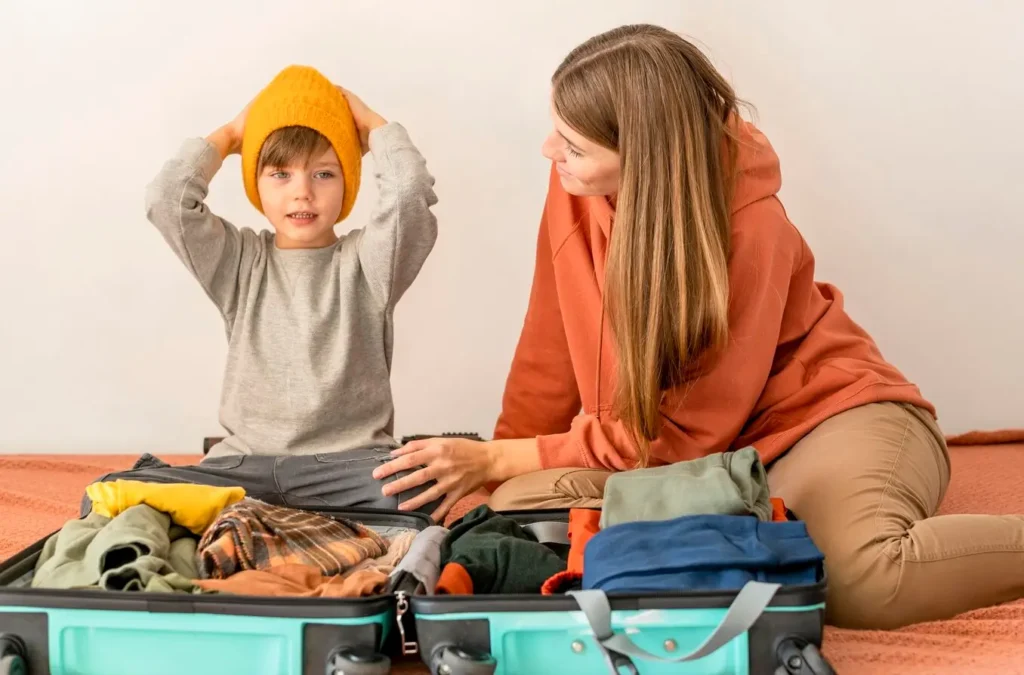
Planning Basics for Any Infant Travel Checklist
The first part of the infant travel checklist focuses on planning.
It looks at:
- Destination and climate
- Trip length
- Available laundry and nearby stores
These details shape the packing list for infant travel, helping parents decide how many outfits, diapers, and layers belong in the bag for each journey.
Newborn Packing List vs Older Infant Checklist
The guide explains the difference between a newborn packing list and a list for an older baby.
Newborns need more swaddles, gentle clothing, and extra diapers, while older infants add items like toys, teething rings, and early feeding tools.
This section also highlights how 5 month old travel essentials fit into the wider infant packing list.
Immediate Essentials in the Infant Travel Checklist
A full Carry-On/Diaper Bag (Immediate Essentials) section shows how to pack the bag that stays within reach during travel.
Here the infant travel checklist covers:
- Diapers, wipes, and changing supplies
- Bottles, formula or breast milk, and simple snacks
- Comfort items such as blankets and pacifiers
- Health items and travel documents
This part forms the flight-ready version of the infant plane travel checklist and supports both short and long journeys.
Essential Infant Travel Items and Gear for Every Trip
A separate gear section lists key infant travel items that suit almost every trip.
This includes car seats, lightweight strollers, baby carriers, and simple safety tools.
These pieces are treated as baby travel must haves inside the overall infant packing list.
Destination, Weather, and Length of Stay
The first step in planning any infant travel checklist is understanding where the trip is going and how long it will last.
Key points to decide:
- Destination type
- City, beach, countryside, or family home
- Climate
- Hot and humid, cold and dry, or mixed weather
- Length of stay
- Weekend, mid-length vacation, or extended visit
A short warm-weather weekend at a familiar family home may only need a few extra outfits and light layers. In that case, the baby packing list can stay fairly compact, with more focus on basics like diapers, wipes, and a few spare bodysuits.
By contrast, a winter trip to a new city calls for more planning. The infant packing list must include thicker sleepwear, warm outer layers, extra socks, and weather protection such as hats and mittens. Longer trips also increase the number of outfits and diapers needed, especially if laundry access is limited.
Once destination, climate, and length of stay are clear, the packing list for infant travel can be scaled up or down without losing structure. The categories stay the same; only the counts and types of clothing change.
Travel Mode: Plane, Car, or Train
The transport type does not change what belongs on the infant travel checklist, but it does change where items are placed and how they are organized. The same categories clothing, diapers, feeding supplies, sleep gear, and infant travel items apply to all trips, yet layout and access differ by mode.
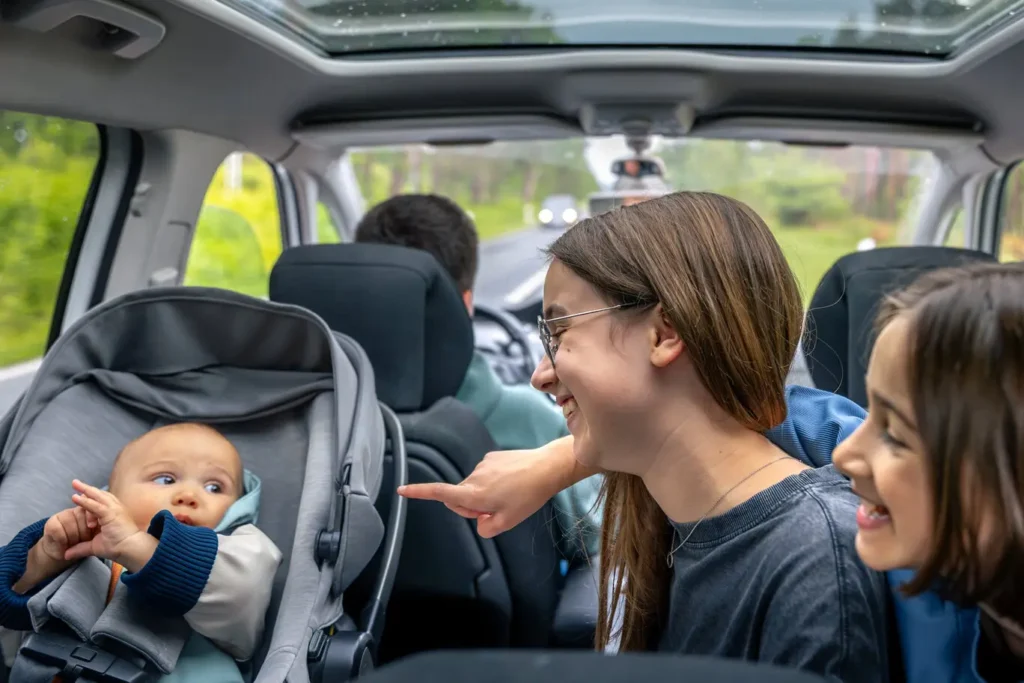
- Plane
- Space is limited and liquid rules apply, so planning centers on the carry-on.
- A focused infant plane travel checklist highlights what must stay within arm’s reach: diapers, wipes, changing pad, bottles, formula or breast milk, baby flight essentials, and comfort items.
- Extra outfits and bulkier items stay in checked luggage or overhead bins.
- Car
- More trunk space allows larger gear and extra supplies to travel without issue.
- A smaller on-hand kit near the car seat covers diaper changes, feeding, and soothing during the drive.
- The rest of the baby travel packing list can remain packed in bags that only come out at stops or at the destination.
- Train
- Compact, easy-to-carry bags matter more, especially when moving between platforms and carriages.
- A slim version of the infant travel checklist stays close to the seat, with diapers, wipes, feeding supplies, and one spare outfit, while heavier items sit on luggage racks.
By thinking about travel mode early, the same infant travel checklist can be arranged in a way that keeps the most urgent items close and less urgent ones stored away, without missing any key category
Trip length and how it shapes a packing list for 5 day trip
Trip length affects quantities more than any other single factor. A packing list for a 5 day trip needs enough supplies to handle normal use plus a buffer for delays and messes.
Common clothing formula for five days:
- Two daytime outfits per day → 10 outfits
- One sleeper or sleep sack per night → 5–7 sleep outfits
- Two extra full outfits for surprise blowouts
Diaper planning often uses:
- About 8–10 diapers per day for younger infants
- Total of 40–50 diapers for five days, plus a small extra pack
If laundry facilities are available, these numbers can drop slightly. If no laundry is available and shops are far away, the same baby packing list may need higher counts or extra stain treatments.
This numeric thinking does not change the structure of the infant travel checklist, but it does keep the list realistic for each kind of trip.
Immediate Essentials for infant travel
The carry-on or diaper bag handles every urgent need during travel, so this section of the infant travel checklist deserves special attention. If a suitcase ends up delayed or locked in a trunk, this bag still supports the baby through delays, layovers, and traffic jams.
Diapering and clean-up in the carry-on
Typical diapering setup includes:
- Diapers for at least one per travel hour, plus extras
- Travel pack of wipes
- Foldable changing pad
- Diaper rash cream in flight-friendly size
- Disposable bags or a small wet bag for soiled items
- Hand sanitizer and surface wipes
These items sit near the top of any flying with a baby checklist, since accidents often happen at the least convenient times.
Feeding and baby flight essentials
Feeding during travel becomes easier with a short list of baby flight essentials:
- Pre-measured formula or breast milk in approved containers
- Bottles and nipples ready for quick use
- Burp cloths and bibs
- Soft snacks for older infants, if age-appropriate
- Spill-resistant cup or bottle for sips during take-off and landing
Together, these pieces form the heart of an infant plane travel checklist, covering hunger, thirst, and pressure changes in baby ears.
Comfort and soothing during transit
Comfort items soften long waits and crowded environments:
- One favorite blanket plus one backup blanket
- At least two pacifiers with clips
- One or two small soft toys
- Light hat and extra layer for chilly cabins
These soothing tools often decide whether a trip feels tiring but manageable or truly difficult. For that reason, they deserve a fixed place on every version of the infant travel checklist.
Health, documents, and backup items
Rounding out the carry-on section:
- Basic baby medicine as approved by a health professional
- Digital thermometer in a small case
- Saline spray and a tiny nasal aspirator
- Copies of health cards, insurance information, and emergency contacts
- Passports, tickets, and reservation details
- Phone, charger, and portable power bank
This group supports both baby and caregiver through unexpected delays or minor health concerns.
Baby travel packing list for the main suitcase
Once the carry-on stands ready, attention turns to the main suitcase. The baby travel packing list here covers day-to-day life at the destination rather than in transit.
Clothing and layers for different climates
A simple method for clothing uses predictable categories:
- Daytime outfits (bodysuit plus pants or one-piece outfits)
- Sleepwear (sleep sacks, pajamas, or footed sleepers)
- Extra bodysuits for layering
- Socks and soft shoes or booties
- Sun hat or warm hat
- Weather-specific outerwear
For a mild climate, thin cotton layers may be enough, while colder trips call for heavier sleepers, sweaters, and a warm coat or snowsuit. Each category receives its own tick mark on the infant travel checklist.
Bath and skincare supplies
Bath-time items sit well in a single pouch:
- Gentle baby wash
- Baby lotion
- Baby shampoo if needed
- Soft washcloths
- Small towel or hooded towel
- Backup diaper cream
Placing them together makes setup in a hotel or guest bathroom simple and prevents spills inside the suitcase.
Feeding gear and food storage at the destination
For feeding at the destination, the packing for infant travel section usually includes:
- Extra bottles and nipples beyond the carry-on count
- Bottle brush and small bottle of dish soap
- Formula container or breast milk storage supplies
- Baby food pouches or jars
- Simple bowl and baby spoon
- Several wipe-able bibs
- Sippy cup or straw cup
Older infants may also benefit from a small snack container for puffs or small pieces of soft food. These items keep feeding schedules close to normal, even far from home.
Sleep setup in the room
Good sleep often decides the overall mood of a trip. A sleep-focused part of the infant travel checklist commonly includes:
- Travel crib or portable bassinet (if not provided)
- Two fitted sheets from home
- Sleep sacks or swaddles, depending on age and preference
- White noise machine or phone app
- Small night light for quiet nighttime diaper changes
A familiar sheet or favorite sleep sack can help babies settle more quickly in new rooms.
Infant travel items and gear that always earn space
Some infant travel items prove useful on almost every trip and rarely leave the list.

Mobility gear
Essential mobility gear often includes:
- Age-appropriate car seat
- Lightweight stroller that folds easily
- Soft baby carrier or wrap
These three pieces support safe transport, naps on the move, and comfortable walks in crowded places. For many families, they clearly rank as core baby travel must haves.
Safety and comfort gear
Other gear items that tend to remain on every infant travel checklist:
- Simple baby first-aid kit
- Outlet covers for curious hands
- Stroller rain cover and sun shade
- Small pack of surface wipes for high-touch areas
These tools may never leave the bag on some trips, but they add a strong sense of readiness when needed.
Newborn packing list and 5 month old travel essentials
Age changes how each section of the infant travel checklist looks.
Newborn packing list focus areas
A newborn packing list usually emphasizes:
- Extra sleepers and bodysuits
- More swaddles and receiving blankets
- Higher diaper counts per day
- Gentle skincare products and cotton pads
- Soft hats and mittens for warmth and scratch control
Newborns sleep more, feed more often, and create frequent diaper changes, so spare clothing and diapers take priority. Toys and complex gear matter less at this stage.
5 month old travel essentials
By around five months, 5 month old travel essentials shift toward activity and curiosity:
- Teething rings and chew-safe toys
- Crinkle books or soft blocks
- Play mat or large blanket for floor time
- Tools for early solids if introduced, such as spoons and silicone bibs
- Extra outfits for food and drool spills
This age brings more movement and more interest in the environment, so the baby travel packing list grows in the play and feeding sections while still keeping core clothes and diaper categories in place.
Sample numbers inside a practical infant travel checklist for five days
A numeric example helps turn the infant travel checklist into a ready-to-use packing list for a 5 day trip.
Example clothing and diaper counts
For one infant over five days:
- 10 daytime outfits
- 5–7 sleep outfits or sleep sacks
- 2 extra full outfits
- 10–12 pairs of socks
- 2 hats appropriate for the climate
- 1–2 jackets or warm layers
Diaper and wipe plan:
- 8–10 diapers per day → 40–50 diapers total
- 1–2 packs of wipes
- 2–3 travel-size creams
- Several disposable bags or one reusable wet bag
These numbers can shift slightly up or down, but they give a functional starting point for any detailed packing list for infant travel.
Example feeding and bath counts
Feeding supplies for five days may include:
- 5–6 bottles and matching nipples
- Formula or pumping supplies plus storage for at least six days
- Enough baby food pouches or jars for each meal, plus backups
- 5–7 bibs
- 4–6 burp cloths
Bath and skincare:
- One travel bottle of baby wash
- One travel bottle of baby lotion
- 3–4 washcloths
- 1–2 towels
Together, these examples give parents a clearer sense of scale when filling out each section of the baby packing list.
Simple system for packing for infant travel
Packing becomes easier when the infant travel checklist turns into a simple repeatable system rather than a one-time exercise.
Step-by-step packing routine
A common routine looks like this:
- Print or open the checklist.
- Start with the carry-on or diaper bag section.
- Move to clothing and diapers for the suitcase.
- Add feeding, bath, and skincare supplies.
- Pack sleep gear and check space for the travel crib.
- Load larger infant travel items such as strollers and car seats.
- Do one last sweep using the checklist before leaving.
Each step can be handled by one or two adults, and tasks can be shared easily because the structure is clear.
Keeping the baby travel packing list updated
After every trip, a quick review helps refine the baby travel packing list:
- Items that never leave the suitcase can be removed next time.
- Items used constantly can be highlighted or starred.
- New needs discovered on the trip can be added to the next version.
Over time, the infant travel checklist becomes more accurate for that specific family’s habits, destinations, and comfort levels.
